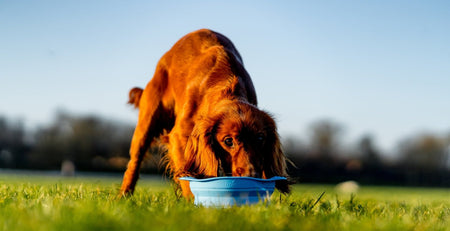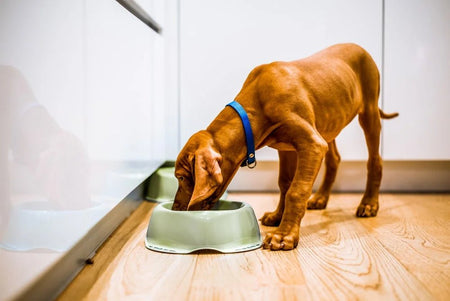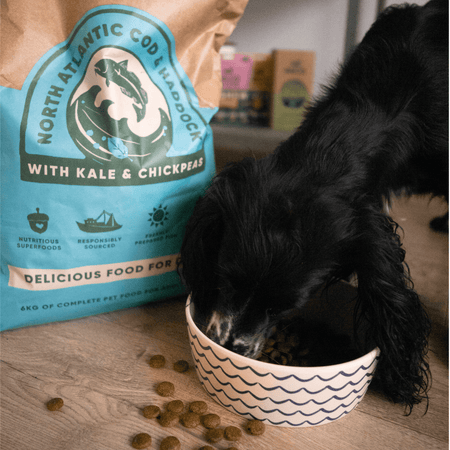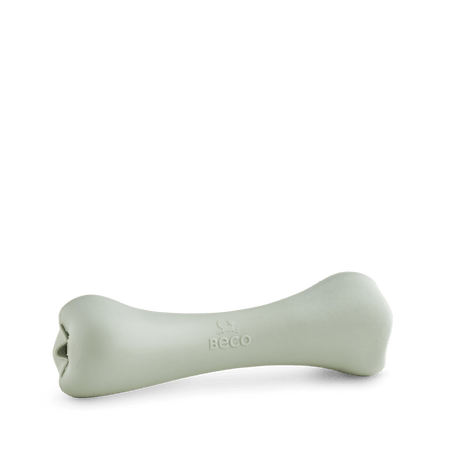Your pup's waistline tells a story. In the UK, over 50% of dogs carry extra weight, turning daily walks into struggles and playtime into naps.
Obesity in dogs strikes at the heart of their happiness - from creaky joints to shortened lives.
But here's the truth: your dog's weight journey isn't set in stone. Simple switches in food, movement, and habits create tail-wagging transformations.
Let's turn their health around.
- Over half of UK dogs battle obesity, affecting everything from daily walks to life expectancy.
- Breeds like Labradors and Beagles face higher obesity risks, with genetics stacking the deck against healthy weight maintenance.
- Beyond portion control, puzzle feeders and swimming offer smart ways to boost physical and mental stimulation during weight loss.
What Causes Obesity in Dogs?
The top cause of canine obesity is overfeeding. Giving your pup more calories than they need leads to weight gain. Those pleading eyes may tempt you to offer an extra treat or two, but it adds up quickly.
In the UK, veterinary professionals estimate that 46% of dogs are overweight or obese, with small and medium-sized breeds being particularly at risk.
Overweight dogs are at a higher risk of developing conditions such as arthritis, diabetes, and heart disease.
Here are a few more reasons why your dog may be packing on the kilos:
Lack of Exercise
Pets need daily movement to burn calories. Without enough exercise, energy gets stored as fat. Physical activity matters, whether it’s a stroll in the park or a game of fetch.
Medical Issues
Conditions like hypothyroidism and Cushing’s disease can slow metabolism, making weight management harder.
Hypothyroidism is a condition where the thyroid gland underproduces hormones, leading to symptoms like weight gain, lethargy, and hair thinning in dogs.
Cushing’s disease is a disorder caused by excessive cortisol production, often resulting in increased appetite, thirst, urination, and abdominal enlargement in dogs.
Regular vet check-ups can rule out these issues.
Breed Predispositions
Some breeds are more prone to being overweight. Labradors, Beagles, Dachshunds, and Bulldogs are just a few that need extra vigilance.
If you own one of these breeds, keep an eye on their waistline.

The Risks of Obesity in Dogs
If your pup is severely overweight, it isn’t just inconvenient; it’s dangerous. Here’s what’s at stake:
-
Joint Pain: Extra weight strains joints, leading to arthritis and reduced mobility. It’s a vicious cycle because pain discourages movement, worsening the problem.
-
Diabetes: Overweight dogs are more prone to insulin resistance, increasing the likelihood of diabetes.
-
Heart and Lung Problems: Fat deposits can strain the heart and make breathing harder, especially in breeds with shorter snouts like Pugs and Bulldogs.
-
Reduced Life Expectancy: Studies show that overweight dogs’ life expectancy is much shorter than their fitter counterparts. This isn’t just about years lost; it’s about quality of life.
-
Cancer Risk: Obesity can also increase the likelihood of certain types of cancer.
How Can You Help Your Overweight Pet?
If you’re worried about overweight dog symptoms, don’t panic. The good news is that with the right steps, you can help your furry friend shed those extra kilos.
1. Visit Your Vet
Before starting any weight-loss plan, consult a vet. They’ll check for underlying medical conditions and create a tailored plan for your pet.
2. Manage Portions
Measure your pup’s portion sizes accurately with a kitchen scale. Don’t rely on guesswork.
Stick to feeding guidelines and follow the recommendations on your pet’s food packaging or your vet’s advice.
3. Choose Quality Nutrition
Switch to a weight-control diet if advised. These foods are low in calories but still provide all the nutrients your pet needs.
Grain-free dog food can be a healthier option, but it's important to ensure it provides balanced nutrition.
Look for high-quality options, rich in protein and low in unhealthy fillers, helping maintain your pet's weight while supporting overall health.
4. Limit Treats
Treats should make up no more than 10% of daily calories. Opt for healthy options like those that include carrot, apple or novel proteins.
5. Increase Activity Levels
Take your pup for daily walks and gradually increase walk times if your pet isn’t used to long outings. You can also use toys or games to encourage movement, especially if your pup loves its playtime.
Swimming is another option. This low-impact exercise is excellent for overweight pets with joint pain.
6. Monitor Progress
Track your best friend’s weight weekly. Use a journal or app to log changes.
Celebrate small wins – every kilo lost makes a difference.
How to Tell If Your Dog Is Overweight
It’s not always obvious when a pet is carrying extra weight. How do you know if your dog is overweight?
Start with these checks:
-
Rib Test: Place your hands on their sides. Can you feel their ribs without pressing hard? If not, they may be overweight.
-
Waist Check: Look from above. Do they have an hourglass shape, or is it more of a barrel?
-
Tummy Tuck: From the side, their abdomen should tuck up towards the hind legs. A sagging belly is a warning sign.
These are the early signs of overweight dogs that pet parents should notice:
| Sign | What to Look For |
|---|---|
| Weight Gain | Noticeable increase in body weight. |
| No Visible Waistline | No inward curve between the ribcage and hips when viewed from above. |
| Difficulty Feeling Ribs | Inability to easily feel ribs because of fat. |
| Distended Abdomen | Protruding or sagging belly. |
| Lethargy | Lack of energy and more time sleeping. |
| Difficulty Breathing | Heavy panting, shortness of breath. |
| Exercise Intolerance | Quick exhaustion during walks or play. |
| Fat Deposits | Accumulation of fat in hips, neck or base of the tail. |
| Poor Grooming Habits | Difficulty in self-grooming. |
| Joint Stiffness or Lameness | Signs of discomfort or limping. |
Body Condition Score (BCS): A Handy Tool
Knowing how to tell if a dog is overweight starts with the BCS system. It uses visual and tactile cues to score pets on a scale of 1 to 9, where 1 is severely underweight, 5 is ideal, and 9 is obese.
Your vet can show you how to assess your pet’s BCS at home. It’s a simple yet effective way to keep track of their health.
Frequently Asked Questions
What are the symptoms of obesity in dogs?
The main symptoms of obesity in dogs include difficulty feeling ribs, a lack of a visible waist, and a sagging belly. Your pet may also tire easily, breathe heavily after light activity, or show reluctance to move.
How do you treat obesity in dogs?
Treating your obese dog involves portion control, regular exercise, and, in some cases, switching to weight-control food. Always work with your vet to create a plan tailored to your pet’s needs. It’s not about quick fixes but consistent effort.
What dog breeds are prone to being overweight?
Breeds like Labradors, Dachshunds, Beagles, and Bulldogs are genetically predisposed to weight gain. As a pet parent, you’ll need to be extra vigilant with these breeds.
Conclusion
Obesity in dogs isn't just numbers on a scale; it's about your pup's vitality, happiness, and longevity.
From portion control to proper nutrition, every step you take shapes their future. Watch their waistline, track their treats, and keep them moving. Their health transformation starts with smart choices.
Looking for ways to keep your dog fit and thriving? Shop our nutrient-rich dog food and treats designed to support healthy weight management and overall wellness today.


















